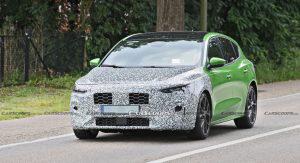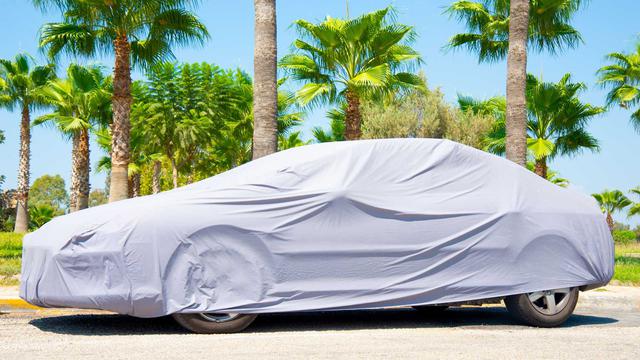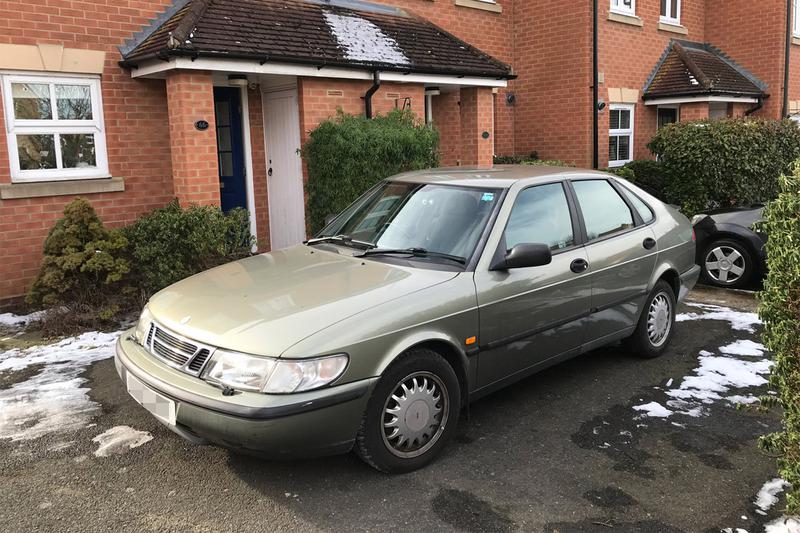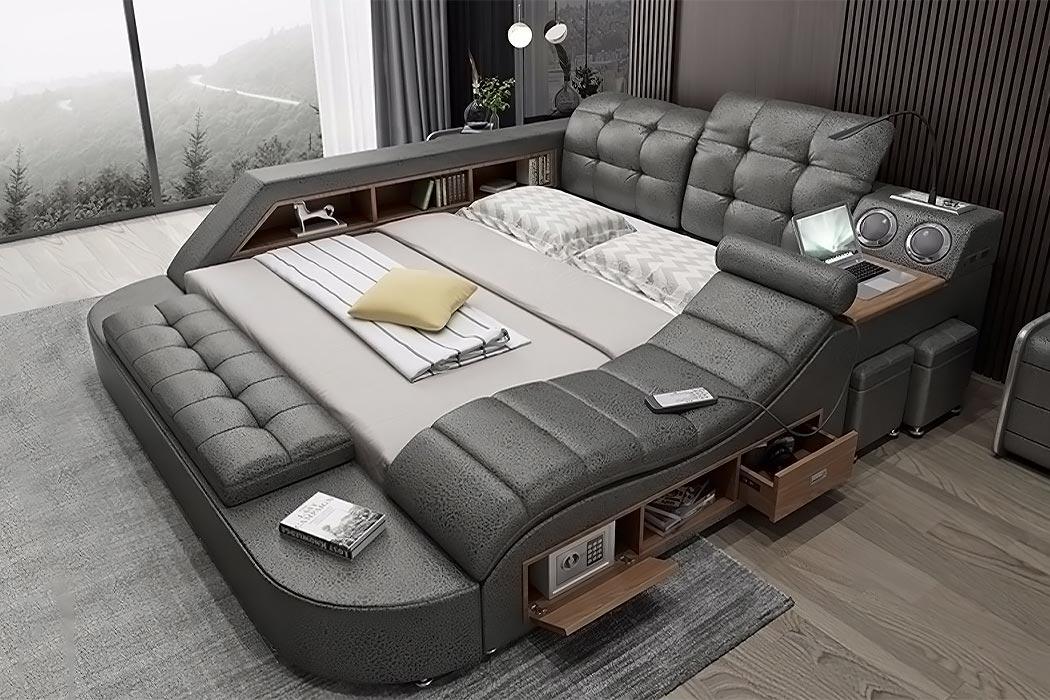A new Ford Focus is coming. And we have the old Ford Laser to thank for it.
More on that later. First, let’s focus on the future Focus.
Due early next year, the facelifted version of Ford’s seminal small car has been snapped wearing the usual camo and disguise, in preparation for an unveiling sometime before the end of this year in Europe.
To bring you up to speed, the facelift centres around a redesigned front end – headlights, grille, bumpers and possibly bonnet – as well as restyled tail-lights and rear-bumper diffuser. You can see what we’re talking about at this link.
All are usual fare. Inside, it’s widely expected that Ford’s SYNC4 multimedia system will debut, leading some reports to speculate whether a dashboard redesign in the mould of China’s Evos or the Mustang e SUV is on the cars, particularly as both these models ride on variations of the C2 architecture that first saw the light of day in the – you’ve guessed it – current Focus back in 2018.
Whether an increase in electrification in terms of greater hybridisation options associated with the 1.0-litre and 1.5-litre three-cylinder turbo-petrol engines also materialise in the German small car’s makeover is still anybody’s guess. Several reports suggest that a plug-in hybrid electric vehicle (PHEV) version will be introduced, while mild-hybrid tech with a larger battery to capture regenerative braking energy is set to be implemented on several grades to help cut emissions and fuel consumption as well as boost performance.
But what does this all mean for Australia?
While it’s almost certain that the rapid Focus ST flagship will fly the Blue Oval flag against the likes of the Volkswagen Golf GTI, questions have long persisted about the viability of continuing the lesser grades of Focus to Australia, leaving the hot-hatch version as the sole representative in much the same way as the smaller Ford Fiesta ST is sold here nowadays.
Will Ford Australia continue with the wildly underrated ST-Line? Will the equally unappreciated Active mild crossover version gain a few more SUV cues in its appearance and ride height to better compete against the Subaru XV that clearly inspired it? Is there a chance that the expected Focus PHEV might thrust the local arm into this new era of electrification at last? Our fingers are crossed.
There’s more, too. Will we ever see the return of the cheap Ford small car? Australia lost the entry-level Focus Ambiente and Focus Trend as well as the svelte ST-Line wagon (what a shame!) in early 2020 after dismal local sales, leaving the brand without a base Toyota Corolla competitor for the first time since, incredibly, the 1930s.
Think about that. From Model Y, Prefect, Anglia and Escort to Laser and Focus, Ford Australia either assembled or imported small cars for everybody continuously in this country since before World War II. But, since last year, they’re now out of reach for many buyers. The cheapest 2021 Focus is the Active and ST-Line grades from $31,000.
The Laser was introduced in 1981.
With the world moving away from small cars and into small SUVs, there is even talk of Ford Europe going the same direction with the Focus’ successor in about 2025, abandoning the traditional hatchback altogether. People want a high-riding crossover.
Until if/when that happens, we’re reasonably confident that – as long as there is an ST hot-hatch version made somewhere in the world – the Focus will continue to be imported in Australia beyond the model-year 2022 facelift.
That’s because the Focus’ immediate predecessor in Australia – the Ford Laser – laid the groundwork for our insatiable taste for fun performance small cars right from its beginning. And not just Blue Oval-branded ones either.
Here’s how.
Ford Laser at 40
The Laser was based on Mazda's 323 small car.
There’s little doubt the triumph of the Isuzu/Holden partnership that led to the top-selling Gemini in 1975 inspired Ford Australia to also look to Japan when it came to replacing the slow-selling, outdated, European Escort II.
But while the Gemini followed the-then conventional rear-wheel-drive (RWD) sedan template, the resulting 1981 KA Laser went down a very different path – one that changed Australian small-car buying habits forever.

Based on Mazda's first volume front-wheel-drive (FWD) model, the BD 323/Familia, the Laser came about after Ford Australia sent a design team led by the Herb Grasse to Hiroshima in about 1978 to style the Ford version. After all, Ford owned a big share in Mazda.
That the 1980 323 bore visual similarities to the unrelated FWD Escort III developing concurrently in Germany reportedly led Ford of Europe to accuse Mazda of plagiarism with Ford Australia’s unwitting assistance. It was hugely controversial at the time.
The second-gen KC ‘bubble back’ Laser appeared in 1985.
Built at Ford’s refurbished Homebush plant in Sydney, the Laser wasn’t the first FWD car made in Australia (the British Motor Corporation’s Morris Mini beat it by 20 years), nor even our first FWD hatch (that'd be the Morris 1100-derived Nomad from 1969, while the VW Golf was assembled here in 1976-’77).
But the Laser changed people's minds about FWD, because the Mini and Golf were beset with quality and durability issues, making Australians wary. In fact, until 1981, many people FWD would never catch on on-masse.
Yet the Laser changed all that in a matter of weeks. Ford planned to sell 20,000 cars annually but numbers topped 50,000 units, regularly putting it in the top-four sellers, and giving Ford the added push to finally beat Holden in total sales for the first time in 29 years. Immediately making the Gemini and Toyota Corolla look like yesterday's news, the Laser dominated the local small-car landscape for a decade. It was a smash hit.
Among the models launched was the innovative Laser S (for Sport). At the time, it set the pace as Australia’s first hot hatch, as there just weren’t any sporty/performance rivals like Europe’s Golf GTI (then unavailable locally).
The Laser Turbo paved the way for the boosted TX3.
Ford was on a roll. The S gained added grunt in ’82, a Turbo option three years later, a one-make racing series that launched the career of Holden driver Mark Skaife and – for the beloved Australian-designed, second-gen KC ‘bubble back’ also from ‘85 – the TX3. With a unique three-door body, fuel injection and later turbo and turbo/AWD flagship, this was Australia’s bargain pocket-rocket experience, transcending rivals like the Pulsar ET turbo and Corolla Twin Cam. Laser's appeal was unusually broad.
The TX3 was Ford's hot hatch during the late '80s and early '90s.
The third-gen Laser (1990’s KF) was again Mazda-based, and though still built here, Ford Australia lost the design contract to Detroit because it was also to become the North American Escort. The overwrought American styling left Aussies cold and Laser sales stumbled, leading to local production ceasing when the next Laser (the KJ) arrived from Japan in 1994. Though now more stylish than the previous model, the hot-hatch versions vanished, while 1999’s KN generation lost the visual flair too. Dependable but dull, it wasn't worthy of the Laser badge. Sales tanked.
Ford Australia didn’t revisit the hot-hatch scene until the European LR (for Laser Replacement) Focus Mk1 belatedly landed here in 2002, first with the ST 170, then the rorty XR5 Turbo from 2005, and on to two generations of the ST (2012 LW and 2020 SA).
The KF Laser saw sales begin to decline.
Today, Active-aside, the ST initials are on every Focus sold here, and are likely to carry on with the 2022 facelift, carrying on the sporty tradition started 40 years ago with that first Laser S.
But the Laser’s legacy goes beyond mere performance.
Quality Mazda engineering and a huge investment in resources meant the Homebush workers built the Laser better – and it proved far more reliable – than most other locally-made Fords up until 1981, not least the tired Escort it replaced. It helped drag the entire Australian auto industry up in the eyes of the world and won it new international business.
The Laser was sold in countries such as Japan, Taiwan and Colombia.
Examples included the Australian-designed KC Laser, which soon became the popular Mercury Tracer for North America from 1987 as well; that Laser generation also famously went on to underpin the troubled Ford (and Mercury) SA Capri convertible (1989-94) – two local projects the success of Laser made happen.
More profoundly, it helped shape the Hawke government’s roadmap for continuous, sustainable Australian vehicle manufacturing as the landmark 1984 Button Plan, which – using the Laser’s successful model-sharing model as a template – slashed the number of different models made here from 13 to six, across five car makers, by encouraging rivals to share vehicles. Ford teamed up with Nissan (which had been supplying Holden with the Pulsar-based Astra from ’84 to ’89), Holden paired with Toyota, and Mitsubishi ceased Colt production to supply Magna engines to Ford and Mazda’s respective Courier and B-series one-tonne trucks.
Most of the badge-engineered models like the Corolla-based Holden Nova flopped, missing the obvious point that the Laser’s popularity was due in no small part to its unique styling and identity: most buyers didn’t even realise there was the 323 connection.
The Laser took its final bow in 2002.
Nowadays, there is a generation of Aussies (including your author) who grew up with parents or siblings who owned Lasers, which meant that it was – for many of us – what we learned to drive in, commute to university in, work in, play in, date in, move out with and more. Many rites of passage moments happened with a Laser nearby.
With the aforementioned changing consumer tastes, Ford Australia is unlikely to ever experience a small-car success like the Laser again. Indeed, most earlier attempts like the Anglia and Escort were only bit players, while the Focus that came later has never come close to hitting the same heights.
So, in this 40th anniversary year, happy birthday, Ford Laser. You changed the Australian motoring landscape more than most people realise.




